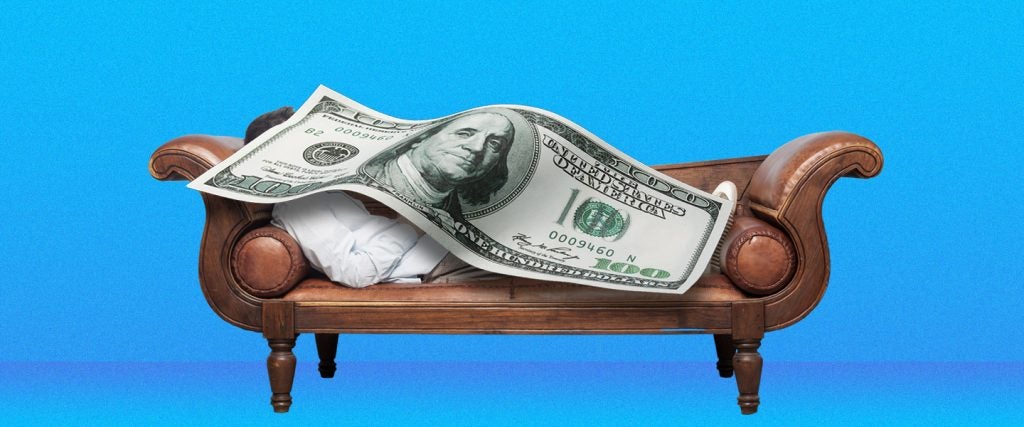Based on the cost of a therapy session these days, it’s easy to assume that most therapists are upper-class Dr. Melfi types who use their practice to buy fine Italian wines and power suits. In reality, though, many therapists aren’t wealthy psychiatrists, psychologists or fictional mob confidants. They’re social workers and counselors who earn closer to what teachers make than what doctors do — averaging a little over $40,000 a year.
So what should therapists reasonably charge for their services? And how do you determine a value for therapy, anyway?
Patrick Turbiville, a psychotherapist and licensed clinical social worker, believes that in a perfect world, therapy would cost whatever the individual can afford to pay. But in his own practice, he plans to raise his rate to $150 a session this year in order to get by (this is after already relocating from Austin to San Antonio to decrease his cost of living).
“There is an inherent and possibly paradoxical competition between the private practice therapist and their clients,” Turbiville explains. In order to do their jobs effectively, therapists have to take care of themselves first. But since most corporations, insurance companies and state and federal governments don’t adequately fund mental-health services or subsidize therapy to make it more affordable, “the powerful have situated two far less powerful but unequally privileged factions against each other.”
Of course, therapists are the ones with more power in the relationship — i.e., they get to name their price. And in order to ensure their own financial stability, clinicians like Turbiville often have to charge more than they’re necessarily comfortable with. He acknowledges $150 a session is high, but at the same time, there are some therapists in his area who charge twice that. “It could be because they have more experience or qualifications, or it could be because that’s just what they decided,” he says.
Raising his rate to $150 allows him to have two or three sliding scale spots for $60 a session, which is still a lot of money for his clients who are struggling financially. While this doesn’t feel like enough to him, it’s what he can do. Many of his colleagues also offer some form of free or discounted services, but “it’s still a privilege to be in a position to choose to do that.”
The transition to teletherapy has helped some clinicians keep their rates affordable by lowering their overhead — no need for an office, etc. But London-based cognitive behavioral therapist Mark Holmes attributes his price point, which ranges from $65 to $90 per 45-minute online session, to his training and experience compared to other professions. “Typically, a therapist will require at least a first degree and postgraduate qualification, often a master’s or doctoral degree, as well as membership of a professional association, and state licensure in the United States,” Holmes explains. “This would put them on the equivalent of a senior manager’s salary.”
Then there are the community mental-health centers, or organizations supported by some combination of government funding and private donations, that offer free or discounted therapy to a limited number of uninsured clients. These centers tend to help individuals apply for Medicaid in order to continue services and open up more uninsured spots. But even when those programs can be fully covered, some organizations will still charge $10 a session “because their funders think it’s detrimental to give people handouts,” Turbiville explains. (Research shows that charging a fee makes no difference in therapeutic outcomes, and some studies show that people actually do better in therapy when they don’t have to worry about paying.)
As much as paying for therapy is a stretch on an individual level, it is cheap for the U.S. and U.K. governments to foot the bill, per a report from the IZA World of Labor on the Economics of Mental Health. “Psychological therapy is a remarkably good bargain,” British economist Richard Layard writes. “For each dollar or pound spent, roughly an equal amount is saved on welfare benefits and an equal amount on physical health care. Thus, with savings per person treated that are at least as high as the cost of treatment — likely higher — treating people suffering from a mental illness imposes no net cost on taxpayers.”
That said, Turbiville is still cautious about assigning a value to therapy. He’s seen far too many group practices recruit new therapists with their master’s degrees to work for a fraction of what their clients pay with no benefits. Plus, app-based therapy options have essentially turned therapists into clinical Uber drivers, offering services below market rate. “Determining a value for therapy is a messy proposition. It’s the wild west,” Turbiville warns. He also believes, though, that “therapy should cost enough that you respect yourself and your clients do too, but not so much that you never see someone that makes less than a living wage.”
It’s currently a tightrope so thin that Turbiville doesn’t feel comfortable walking it himself, and admits that he wouldn’t be able to afford his current therapist if they didn’t take his insurance (a growing number of therapists don’t). And even with insurance, “the co-pay would feel like a bit much if I went every week,” says Turbiville, who goes bi-weekly instead. “It’s too big of a budget item to justify to myself, which is a contradiction I don’t fully understand yet.”
That’s a lot to unpack in therapy every other week.

